Search results for 'Chapter'
-

CMIS 141 Project 1 Java Program
$20.00CMIS 141 Project 1 Java Program
This project demonstrates your understanding of datatypes, input/output, sequential and selection programming statements, and mathematical operations.
Before attempting this project, be sure you have completed all of the reading assignments listed in the syllabus to date, participated in the weekly conferences, and thoroughly understand the examples throughout the chapters. The project requirements include:
1. Design and implement a Java program that will gather a user’s first name, middle initial, lastname, age in years, and 3 lucky numbers. The program should output the following based on the user’s input:
a. A welcome message repeating their full name (e.g. Welcome John Q Smith)
b. A message based on their age with these types of messages.
Display “You are just a kid!”, if the user is less than or equal to 12 years old
Display “Welcome teenager!”, if the user is greater than 12 and less than 20 years old
Display “Welcome almost adult!”, if the user is 20 years old.
Display “Welcome adult!” , if the user is 21 years old or greater.
c. A message displaying the average of their 3 lucky numbers. For example “The average of your 3 lucky numbers is : 20”2. Additional requirements include:
1. Use JOptionPane.showInputDialog() methods for your user to input their data
2. Use JOptionPane.showMessageDialog() methods to display your messages.3. Include a comprehensive set of application test data that you used to test your program. Your test data can be shown in a table that includes input data, expected output, actual output and pass/fail results from the test. Your test data can be presented in the form of a table as follows:
Submission requirements:
Learn More
Your deliverables include a Java file and a Word document. The Java file should be named Yournamep1.java. Your word document should include your test table and be named Yournamep1.doc. Your completed assignment should be submitted to your Project 1 assignment area no later than the due date listed in the calendar. -

Big Java Chapter 8 Programming Exercise P8.3
$5.00Big Java Chapter 8 Programming Exercise P8.3
Real cash registers can handle both bills and coins. Design a single class that expresses the commonality of these concepts. Redesign the CashRegister class and provide a method for entering payments that are described by your class. Your primary challenge is to come up with a good name for the class.
Learn More -
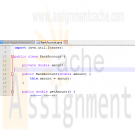
Big Java Chapter 8 Programming Exercise P8.4 BankAccount Solution
$5.00Big Java Chapter 8 Programming Exercise P8.4 BankAccount
Enhance the BankAccount class by adding preconditions for the constructor and the deposit method that require the amount parameter to be at least zero, and a precondition for the withdraw method that requires amount to be a value between 0 and the current balance. Use assertions to test the preconditions.
Learn More -
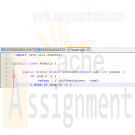
Big Java Chapter 8 Programming Exercise P8.13 Numeric Solution
$5.00Big Java Chapter 8 Programming Exercise P8.13 Numeric Solution
Consider the following algorithm for computing xn for an integer n. If n < 0, xn is 1/x–n. If n is positive and even, then xn = (xn/2)2. If n is positive and odd, then xn = xn–1 ⋅ x. Implement a static method double intPower(double x, int n) that uses this algorithm. Add it to a class called Numeric.
Learn More -
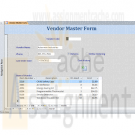
Microsoft Access 2010 Chapter 5 Lab 2 Adding Fields and Creating Multitable Forms for the Walburg Energy Alternatives Database
$25.00Microsoft Access 2010 Chapter 5 Lab 2 Adding Fields and Creating Multitable Forms for the Walburg Energy Alternatives Database
Learn More
Problem: The management of Walburg Energy Alternatives has found that they need to maintain additional data on suppliers. Management needs to keep track of the last date an order was placed, whether the vendor accepts returns, and whether the vendor allows online ordering. Management also would like to attach to each vendor’s record Excel files that contain historical cost data. Walburg Energy Alternatives requires a form that displays information about the vendor as well as the items that are purchased from vendors.
Instructions: If you are using the Microsoft Access 2010 Complete or the Microsoft Access 2010 Comprehensive text, open the Walburg Energy Alternatives database that you used in Chapter 4. Otherwise, see the inside back cover of this book for instructions on downloading the Data Files for Students, or contact your instructor for more information about accessing the required files.
Perform the following tasks:
1. Add the fields Last Order Date, Returns, Online Ordering, and Cost History to the end of the Vendor table structure. Last Order Date is a Date/Time field, Returns and Online Ordering are Yes/No fields, and Cost History is an Attachment field. Create an input mask for the Last Order Date that uses the Short Date input mask.
2. Add the data shown in Table 5 – 3 to the Vendor table.
Table 5 – 3 Data for Vendor Table
Vendor Code Last Order Date Returns Online Ordering Cost History
AS 3/30/2012 Yes No AS_History.xlsx
JM 3/26/2012 No Yes JM_History.xlsx
SD 4/4/2012 Yes Yes SD_History.xlsx
3. Create the form shown in Figure 5 – 88. Use Vendor Master Form as the name of the form and Items of Vendor as the name of the subform. The title is raised, semi-bold, and distributed with a font size of 24. The labels are blue, bold, and etched with a transparent border style. The fields have a sunken special effect.
4. Open the Vendor Master Form and then open the cost history for Asterman Industries. Change the previous cost for item 4553 to $40.95. Save the change to the workbook.
5. Query the Vendor table to find all vendors that accept returns and allow online ordering. Include the Vendor Code and Name in the query results. Save the query as Returns-Online Query.
6. Submit the revised database in the format specified by your instructor. -
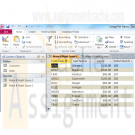
Microsoft Access 2010 Chapter 7 Make It Right Correcting Errors in the Query Design
$20.00Microsoft Access 2010 Chapter 7 Make It Right Correcting Errors in the Query Design
Learn More
Analyze a database, correct all errors, and/or improve the design.
Instructions: Start Access. Open the College Pet Sitters database. See the inside back cover of this book for instructions for downloading the Data Files for Students, or see your instructor for information on accessing the files required in this book.
College Pet Sitters is a database maintained by a small pet-sitting business owned by college students. The queries shown in Figure 7 – 37 contain a number of errors that need to be corrected before the queries run properly. The query shown in Figure 7 – 37a displays the Enter Parameter Value dialog box, but this is not a parameter query. Also, the owners wanted to assign the name, Total Amount, to the Balance + Paid calculation. Save the query with your changes.
When you view the results for the query shown in Figure 7 – 37b, you get 30 records. You know this is wrong. Also, the query did not sort correctly. The query results should be sorted first by sitter number and then by descending balance. Correct the errors and save the query with your changes.
Change the database properties, as specified by your instructor. Submit the revised database in the format specified by your instructor. -

Microsoft Access 2010 Chapter 7 Lab 1 Querying the ECO Clothesline Database Using SQL
$25.00Microsoft Access 2010 Chapter 7 Lab 1 Querying the ECO Clothesline Database Using SQL
Learn More
Problem: The management of ECO Clothesline wants to learn more about SQL and has determined a number of questions it wants SQL to answer. You must obtain answers to the questions posed by management.
Instructions: If you are using the Microsoft Access 2010 Complete or the Microsoft Access 2010 Comprehensive text, open the ECO Clothesline database that you used in Chapter 6. Otherwise, see your instructor for information on accessing the files required in this book.
Perform the following tasks:
1. Find all customers where the customer type is SAL. Include the Customer Number, Customer Name, and Sales Rep Number fields in the result. Save the query as Lab 7-1 Step 1 Query.
2. Find all customers located in Tennessee (TN) with a paid amount greater than $1,500.00. Include the Customer Number, Customer Name, and Amount Paid fields in the result. Save the query as Lab 7-1 Step 2 Query.
3. Find all customers whose names begin with the letter, C. Include the Customer Number, Customer Name, and City fields in the result. Save the query as Lab 7-1 Step 3 Query.
4. List all cities in descending order. Each city should appear only once. Save the query as Lab 7-1 Step 4 Query.
5. Display the customer number, name, sales rep number, first name, and last name for all customers. Sort the results in ascending order by sales rep number and customer number. Save the query as Lab 7-1 Step 5 Query.
6. List the average balance amount grouped by sales rep number. Name the average balance as Average Billed. Save the query as Lab 7-1 Step 6 Query.
7. Find the customer number and name for every pair of customers who are located in the same city. Save the query as Lab 7-1 Step 7 Query.
8. Find the customer numbers, names, and sales rep numbers for all customers that have open orders. Use the alias O for the Open Orders table and C for the Customer table. Each customer should appear only once. Save the query as Lab 7-1 Step 8 Query.
9. Use a subquery to find all sales reps whose customers are located in Pineville. Save the query as Lab 7-1 Step 9 Query.
10. Find the average balance amount for sales rep 44. Save the query as Lab 7-1 Step 10 Query.
11. Submit the revised database in the format specified by your instructor. -

Microsoft Access 2010 Chapter 3 Lab 2 Maintaining the Walburg Energy Alternatives Database
$20.00Microsoft Access 2010 Chapter 3 Lab 2 Maintaining the Walburg Energy Alternatives Database
Problem: The management of the Walburg Energy Alternatives recently acquired some items from a store that is going out of business. You now need to append these new items to the current item table. You also need to change the database structure and add some validation rules to the database.
Use the database modified in the In the Lab 2 of Chapter 2 on page AC 134 for this assignment. You also will use the More Items database from the Data Files for Students. See the inside back cover of this book for instructions for downloading the Data Files for Students, or see your instructor for information on accessing the required files.Perform the following tasks:
Learn More
1. Open the More Items database from the Data Files for Students.
2. Create a new query for the Item table and add all fields to the query.
3. Using an append query, append all records in the More Items database to the Item table in the Walburg Energy Alternatives database, as shown in Figure 3 – 87.
4. Save the append query as Walburg Append Query and close the More Items database.
5. Open the Walburg Energy Alternatives database and then open the Item table in Datasheet view. There should be 20 records in the table.
6. The items added from the More Items database do not have a vendor assigned to them. Assign items 1234 and 2234 to vendor JM. Assign item 2216 to vendor AS. Assign items 2310 and 2789 to vendor SD.
7. Create an advanced filter for the Item table. The filter should display records with fewer than 10 items on hand and be sorted in ascending order by Description. Save the filter settings as a query and name the filter Reorder Filter.
8. Make the following changes to the Item table:
a. Change the field size for the On Hand field to Integer. The Format should be fixed and the decimal places should be 0.
b. Make Description a required field.
c. Specify that the number on hand must be between 0 and 50. Include validation text.
d. Add a calculated field Inventory Value (On Hand*Cost) following the Cost field. Format the field as currency.
9. Save the changes to the table design. If a dialog box appears indicating that some data may be lost, click the Yes button.
10. Add the Inventory Value field to the Inventory Status Report. Place the field after the Cost field. Save the changes to the report.
11. Specify referential integrity between the Vendor table (the one table) and the Item table (the many table). Cascade the update but not the delete.
12. Submit the revised More Items database and the Walburg Energy Alternatives database in the format specified by your instructor. -
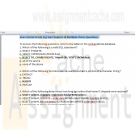
Joan Casteel Oracle 11g SQL Chapters 10 Multiple Choice Questions Solution
$12.00Joan Casteel Oracle 11g SQL Chapters 10 Multiple Choice Questions Solution
To answer the following questions, refer to the tables in the JustLee Books database.
1. Which of the following is a valid SQL statement?
a. SELECT SYSDATE;
b. SELECT UPPER(Hello) FROM dual;
c. SELECT TO_CHAR(SYSDATE, 'Month DD, YYYY') FROM dual;
d. all of the above
e. none of the above2. Which of the following functions can be used to extract a portion of a character string?
a. EXTRACT
b. TRUNC
c. SUBSTR
d. INITCAP3. Which of the following determines how long ago orders that haven’t shipped were received?
a. SELECT order#, shipdate-orderdate delay FROM orders;
b. SELECT order#, SYSDATE – orderdate FROM orders WHERE shipdate IS NULL;
c. SELECT order#, NVL(shipdate, 0) FROM orders WHERE orderdate is NULL;
d. SELECT order#, NULL(shipdate) FROM orders;4. Which of the following SQL statements produces “Hello World” as the output?
a. SELECT "Hello World" FROM dual;
b. SELECT INITCAP('HELLO WORLD') FROM dual;
c. SELECT LOWER('HELLO WORLD') FROM dual;
d. both a and b
e. none of the above5. Which of the following functions can be used to substitute a value for a NULL value?
a. NVL
b. TRUNC
c. NVL2
d. SUBSTR
e. both a and d
f. both a and c6. Which of the following is not a valid format argument for displaying the current time?
a. 'HH:MM:SS'
b. 'HH24:SS'
c. 'HH12:MI:SS'
d. All of the above are valid.7. Which of the following lists only the last four digits of the contact person’s phone number at American Publishing?
a. SELECT EXTRACT(phone, -4, 1) FROM publisher WHERE name ¼ 'AMERICAN PUBLISHING';
b. SELECT SUBSTR(phone, -4, 1) FROM publisher WHERE name = 'AMERICAN PUBLISHING';
c. SELECT EXTRACT(phone, -1, 4) FROM publisher WHERE name = 'AMERICAN PUBLISHING';
d. SELECT SUBSTR(phone, -4, 4) FROM publisher WHERE name = 'AMERICAN PUBLISHING';8. Which of the following functions can be used to determine how many months a book has been available?
a. MONTH
b. MON
c. MONTH_BETWEEN
d. none of the above9. Which of the following displays the order date for order 1000 as 03/31?
a. SELECT TO_CHAR(orderdate, 'MM/DD') FROM orders WHERE order# = 1000;
b. SELECT TO_CHAR(orderdate, 'Mth/DD') FROM orders WHERE order# = 1000;
c. SELECT TO_CHAR(orderdate, 'MONTH/YY') FROM orders WHERE order# = 1000;
d. both a and b
e. none of the above10. Which of the following functions can produce different results, depending on the value of a specified column?
a. NVL
b. DECODE
c. UPPER
d. SUBSTR11. Which of the following SQL statements is not valid?
a. SELECT TO_CHAR(orderdate, '99/9999') FROM orders;
b. SELECT INITCAP(firstname), UPPER(lastname) FROM customers;
c. SELECT cost, retail, TO_CHAR(retail-cost, '$999.99') profit FROM books;
d. all of the above12. Which function can be used to add spaces to a column until it’s a specific width?
a. TRIML
b. PADL
c. LWIDTH
d. none of the above13. Which of the following SELECT statements returns 30 as the result?
a. SELECT ROUND(24.37, 2) FROM dual;
b. SELECT TRUNC(29.99, 2) FROM dual;
c. SELECT ROUND(29.01, -1) FROM dual;
d. SELECT TRUNC(29.99, -1) FROM dual;14. Which of the following is a valid SQL statement?
a. SELECT TRUNC(ROUND(125.38, 1), 0) FROM dual;
b. SELECT ROUND(TRUNC(125.38, 0) FROM dual;
c. SELECT LTRIM(LPAD(state, 5, ' '), 4, -3, "*") FROM dual;
d. SELECT SUBSTR(ROUND(14.87, 2, 1), -4, 1) FROM dual;15. Which of the following functions can’t be used to convert the letter case of a character string?
a. UPPER
b. LOWER
c. INITIALCAP
d. All of the above can be used for case conversion.16. Which of the following format elements causes months to be displayed as a three-letter abbreviation?
a. MMM
b. MONTH
c. MON
d. none of the above17. Which of the following SQL statements displays a customer’s name in all uppercase
characters?
a. SELECT UPPER('firstname', 'lastname') FROM customers;
b. SELECT UPPER(firstname, lastname) FROM customers;
c. SELECT UPPER(lastname, ',' firstname) FROM customers;
d. none of the above18. Which of the following functions can be used to display the character string FLORIDA in the query results whenever FL is entered in the State field?
a. SUBSTR
b. NVL2
c. REPLACE
d. TRUNC
e. none of the above19. What’s the name of the table provided by Oracle 11g for completing queries that don’t involve a table?
a. DUMDUM
b. DUAL
c. ORAC
d. SYS20. If an integer is multiplied by a NULL value, the result is:
Learn More
a. an integer
b. a whole number
c. a NULL value
d. None of the above—a syntax error message is returned. -
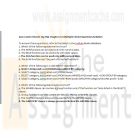
Joan Casteel Oracle 11g SQL Chapters 11 Multiple Choice Questions Solution
$12.00Joan Casteel Oracle 11g SQL Chapters 11 Multiple Choice Questions Solution
To answer these questions, refer to the tables in the JustLee Books database.
1. Which of the following statements is true?
a. The MIN function can be used only with numeric data.
b. The MAX function can be used only with date values.
c. The AVG function can be used only with numeric data.
d. The SUM function can’t be part of a nested function.2. Which of the following is a valid SELECT statement?
a. SELECT AVG(retail-cost) FROM books GROUP BY category;
b. SELECT category, AVG(retail-cost) FROM books;
c. SELECT category, AVG(retail-cost) FROM books WHERE AVG(retail-cost) > 8.56 GROUP BY category;
d. SELECT category, AVG(retail-cost) Profit FROM books GROUP BY category HAVING profit > 8.56;3. Which of the following statements is correct?
a. The WHERE clause can contain a group function only if the function isn’t also listed in the SELECT clause.
b. Group functions can’t be used in the SELECT, FROM, or WHERE clauses.
c. The HAVING clause is always processed before the WHERE clause.
d. The GROUP BY clause is always processed before the HAVING clause.4. Which of the following is not a valid SQL statement?
a. SELECT MIN(pubdate) FROM books GROUP BY category HAVING pubid = 4;
b. SELECT MIN(pubdate) FROM books WHERE category = 'COOKING';
c. SELECT COUNT(*) FROM orders WHERE customer# = 1005;
d. SELECT MAX(COUNT(customer#)) FROM orders GROUP BY customer#;5. Which of the following statements is correct?
a. The COUNT function can be used to determine how many rows contain a NULL value.
b. Only distinct values are included in group functions, unless the ALL keyword is included in the SELECT clause.
c. The HAVING clause restricts which rows are processed.
d. The WHERE clause determines which groups are displayed in the query results.
e. none of the above6. Which of the following is a valid SQL statement?
a. SELECT customer#, order#, MAX(shipdate-orderdate) FROM orders GROUP BY customer# WHERE customer# = 1001;
b. SELECT customer#, COUNT(order#) FROM orders GROUP BY customer#;
c. SELECT customer#, COUNT(order#) FROM orders GROUP BY COUNT(order#);
d. SELECT customer#, COUNT(order#) FROM orders GROUP BY order#;7. Which of the following SELECT statements lists only the book with the largest profit?
a. SELECT title, MAX(retail-cost) FROM books GROUP BY title;
b. SELECT title, MAX(retail-cost) FROM books GROUP BY title HAVING MAX(retail-cost);
c. SELECT title, MAX(retail-cost) FROM books;
d. none of the above8. Which of the following is correct?
a. A group function can be nested inside a group function.
b. A group function can be nested inside a single-row function.
c. A single-row function can be nested inside a group function.
d. a and b
e. a, b, and c9. Which of the following functions is used to calculate the total value stored in a specified column?
a. COUNT
b. MIN
c. TOTAL
d. SUM
e. ADD10. Which of the following SELECT statements lists the highest retail price of all books in the Family category?
a. SELECT MAX(retail) FROM books WHERE category = 'FAMILY';
b. SELECT MAX(retail) FROM books HAVING category = 'FAMILY';
c. SELECT retail FROM books WHERE category = 'FAMILY' HAVING MAX(retail);
d. none of the above11. Which of the following functions can be used to include NULL values in calculations?
a. SUM
b. NVL
c. MAX
d. MIN12. Which of the following is not a valid statement?
a. You must enter the ALL keyword in a group function to include all duplicate values.
b. The AVG function can be used to find the average calculated difference between two dates.
c. The MIN and MAX functions can be used on any type of data.
d. all of the above
e. none of the above13. Which of the following SQL statements determines how many total customers were referred by other customers?
a. SELECT customer#, SUM(referred) FROM customers GROUP BY customer#;
b. SELECT COUNT(referred) FROM customers;
c. SELECT COUNT(*) FROM customers;
d. SELECT COUNT(*) FROM customers WHERE referred IS NULL;Use the following SELECT statement to answer questions 14–18:
1 SELECT customer#, COUNT(*)
2 FROM customers JOIN orders USING (customer#)
3 WHERE orderdate > '02-APR-09'
4 GROUP BY customer#
5 HAVING COUNT(*) > 2;14. Which line of the SELECT statement is used to restrict the number of records the query processes?
a. 1
b. 3
c. 4
d. 515. Which line of the SELECT statement is used to restrict groups displayed in the query results?
a. 1
b. 3
c. 4
d. 516. Which line of the SELECT statement is used to group data stored in the database?
a. 1
b. 3
c. 4
d. 517. Because the SELECT clause contains the Customer# column, which clause must be included for the query to execute successfully?
a. 1
b. 3
c. 4
d. 518. The COUNT(*) function in the SELECT clause is used to return:
a. the number of records in the specified tables
b. the number of orders placed by each customer
c. the number of NULL values in the specified tables
d. the number of customers who have placed an order19. Which of the following functions can be used to determine the earliest ship date for all orders recently processed by JustLee Books?
a. COUNT function
b. MAX function
c. MIN function
d. STDDEV function
e. VARIANCE function20. Which of the following is not a valid SELECT statement?
Learn More
a. SELECT STDDEV(retail) FROM books;
b. SELECT AVG(SUM(retail)) FROM orders NATURAL JOIN orderitems NATURAL JOIN books GROUP BY customer#;
c. SELECT order#, TO_CHAR(SUM(retail),'999.99') FROM orderitems JOIN books USING (isbn) GROUP BY order#;
d. SELECT title, VARIANCE(retail-cost) FROM books GROUP BY pubid;





